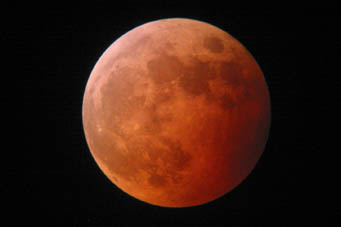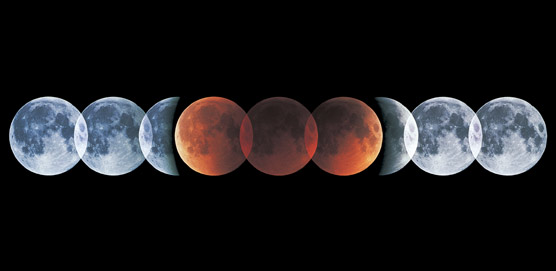Contact:
Alan MacRobert, Senior Editor
855-638-5388 x2151, [email protected]
| Note to Editors/Producers: This release is accompanied by high-quality graphics; see the end of this release.For more information and a map of the eclipse's visibility, please direct your readers/viewers to our online story about the eclipse. |
North America hasn't had a total eclipse of the Moon since 2011. But this long dry spell will break early on April 15th (beginning late on April 14th for the West Coast), when the full Moon passes through the umbra — the dark inner core of Earth's shadow.
The diagram and timetable below tell what to expect and when if you live in North America. The eclipse will also be visible from South America and much of the Pacific. In eastern Australia the Moon doesn't rise until the total eclipse is already underway on the evening of the 15th.
What to Look For
A total lunar eclipse has five stages, with different things to watch at each:
Penumbral eclipse: Shading starts to occur when the Moon's leading edge enters Earth's penumbra, the outer portion of its shadow. But initially the effect is weak — you won't start to see a dusky fringe along the Moon's leading limb (celestial east) until the disk intrudes about halfway across the penumbra. As the Moon glides deeper in, the shading becomes much more obvious.
Partial eclipse: More dramatic is the Moon's entrance into the umbra, where no direct sunlight reaches the lunar surface. Few sights in astronomy are more eerie and impressive than watching this red-black shadow creeping, minute by minute, across the bright lunar landscape, slowly engulfing one crater after another. If you're so inclined, there's scientific value in carefully timing these crater crossings.
As more of the Moon slides into the umbra, a second, deeper night is falling around you as more stars come out in what had been a full-Moon-washed sky. An hour or so into partial eclipse, only a final bright sliver remains outside the umbra and the rest of the Moon is already showing an eerie reddish glow.

Taking a break from Game 4 of the World Series on October 27, 2004, Rick Fienberg snapped this view of that evening's total eclipse of the Moon. Click on the image for a larger version.
Sky & Telescope photo by Richard Tresch Fienberg
Total eclipse: From the Moon's perspective, the Sun remains completely hidden for 1 hour 18 minutes. From Earth's perspective, the lunar disk isn't completely blacked out but instead remains dimly lit by a deep orange or red glow. Why so?
Our atmosphere scatters and refracts (bends) sunlight that grazes the rim of our globe, so that red glow comes from all the sunrises and sunsets around Earth's terminator at the moment. If you were an astronaut standing on the Moon, you'd see Earth ringed with a thin, brilliant band of sunset- and sunrise-colored light. On rare occasions the eclipsed Moon does go black. Other times it appears as bright and coppery as a new penny. Sometimes it turns brown like chocolate, or as dark red as dried blood.
Two factors affect an eclipse's color and brightness. The first is simply how deeply the Moon goes into the umbra — the umbra's center is much darker than its outer edge. The second is the state of Earth's atmosphere all around the terminator. If the air is very clear, the eclipse is bright; if it's mostly cloudy (or polluted with volcanic ash from a major eruption), the eclipse will be dark red, ashen gray, or almost black.
[caption id="attachment_254246073" align="alignleft
 Aligning his camera on the same star for nine successive exposures, Sky & Telescope contributing photographer Akira Fujii captured this record of the Moon’s progress dead center through the Earth’s shadow in July 2000.
Aligning his camera on the same star for nine successive exposures, Sky & Telescope contributing photographer Akira Fujii captured this record of the Moon’s progress dead center through the Earth’s shadow in July 2000.
Akira Fujii
Adding to the late-night spectacle will be the bright star Spica shining only about 1° or 2° from the Moon and brilliant Mars about 9° to the west.
Partial eclipse: Totality ends once the Moon's leading limb peeks back into direct sunlight, and after that events unfold in reverse order. If you're using binoculars or a small telescope to view the eclipse, watch as lunar features slide back into full view.
Penumbral eclipse: When all of the Moon has escaped the umbra, only the last, penumbral shading is left. This final duskiness gradually fades away, leaving the full Moon shining as bright and white as ever. Notably, of the three lunar eclipses in 2013, two were penumbra-only events.
| Total eclipse of the Moon, April 14-15, 2014* | |||||
| Eclipse event | UT | EDT | CDT | MDT | PDT |
| Penumbra first visible? | 5:20 | 1:20 a.m. | 12:20 a.m | 11:20 p.m. | 10:20 p.m. |
| Partial eclipse begins | 5:58 | 1:58 a.m. | 12:58 a.m. | 11:58 p.m. | 10:58 p.m. |
| Total eclipse begins | 7:07 | 3:07 a.m. | 2:07 a.m. | 1:07 a.m. | 12:07 a.m. |
| Mid-eclipse | 7:46 | 3:46 a.m. | 2:46 a.m | 1:46 a.m. | 12:46 a.m. |
| Total eclipse ends | 8:25 | 4:25 a.m. | 3:25 a.m. | 2:25 a.m. | 1:25 a.m. |
| Partial eclipse ends | 9:33 | 5:33 a.m. | 4:33 a.m. | 3:33 a.m. | 2:33 a.m. |
| Penumbra last visible? | 10:10 | — | 5:10 a.m. | 4:10 a.m. | 3:10 a.m. |
* Note: all a.m. times are for April 15th; all p.m. times are for April 14th
If it's cloudy from your location in North America, you won't have another long wait for the next total lunar eclipse. The next one comes on the morning of October 8th for the whole continent except the farthest northeast. In fact, April's event is the first of four consecutive total lunar eclipses in 2014–15! Such eclipse tetrads are not common — the last one occurred a decade ago, but the next won't begin until 2032.
For more skywatching information and other astronomy news, visit SkyandTelescope.com or pick up Sky & Telescope, the essential magazine of astronomy since 1941.
Sky & Telescope is making the below photographs available to editors and producers. Permission is granted for one-time, nonexclusive use in print and broadcast media, as long as appropriate credits (as noted) are included. Web publication must include a link to SkyandTelescope.com.
Eclipse times for Universal Time:
Eclipse times for Pacific Daylight Time:
[caption id="attachment_253913722" align="alignnone
 Late-night skywatchers get to witness a total lunar eclipse in the early morning of April 15, 2014. (For West Coast observers, early phases of the eclipse occur late on April 14th.) Due to the Moon's off-center path through Earth's umbra, the northern half of its disk should look especially dark during totality.
Late-night skywatchers get to witness a total lunar eclipse in the early morning of April 15, 2014. (For West Coast observers, early phases of the eclipse occur late on April 14th.) Due to the Moon's off-center path through Earth's umbra, the northern half of its disk should look especially dark during totality.
Eclipse times for Mountain Daylight Time:
Eclipse times for Central Daylight Time:
[caption id="attachment_253913721" align="alignnone
 Late-night skywatchers get to witness a total lunar eclipse in the early morning of April 15, 2014. (For West Coast observers, early phases of the eclipse occur late on April 14th.) Due to the Moon's off-center path through Earth's umbra, the northern half of its disk should look especially dark during totality.
Late-night skywatchers get to witness a total lunar eclipse in the early morning of April 15, 2014. (For West Coast observers, early phases of the eclipse occur late on April 14th.) Due to the Moon's off-center path through Earth's umbra, the northern half of its disk should look especially dark during totality.
Eclipse times for Eastern Daylight Time:
[caption id="attachment_253913717" align="alignnone
 Use this map to determine whether the Moon sets or rises during any stage of April's eclipse. Because an eclipsed Moon is always full, moonset or moonrise happens in a very bright sky. Click on the image for a high-resolution version.
Use this map to determine whether the Moon sets or rises during any stage of April's eclipse. Because an eclipsed Moon is always full, moonset or moonrise happens in a very bright sky. Click on the image for a high-resolution version.

Taking a break from Game 4 of the World Series on October 27, 2004, Rick Fienberg snapped this view of that evening's total eclipse of the Moon. Click on the image for a larger version.
Sky & Telescope photo by Richard Tresch Fienberg

Aligning his camera on the same star for nine successive exposures, Sky & Telescope contributing photographer Akira Fujii captured this record of the Moon”™s progress dead center through the Earth”™s shadow in July 2000. This image is available as a publication-quality JPEG (1.5 megabytes).
Sky & Telescope / Akira Fujii
 8
8